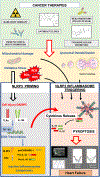NLRP3-mediated inflammation in cardio-oncology: sterile yet harmful
- PMID: 35948198
- PMCID: PMC9839540
- DOI: 10.1016/j.trsl.2022.08.004
NLRP3-mediated inflammation in cardio-oncology: sterile yet harmful
Abstract
Despite significant advances and the continuous development of novel, effective therapies to treat a variety of malignancies, cancer therapy-induced cardiotoxicity has been identified as a prominent cause of morbidity and mortality, closely competing with secondary malignancies. This unfortunate limitation has prompted the inception of the field of cardio-oncology with its purpose to provide the necessary knowledge and key information on mechanisms that support the use of the most efficacious cancer therapy with minimal or no interruption while paying close attention to preventing cardiovascular related morbidity and mortality. Several mechanisms that contribute to cancer therapy-induced cardiotoxicity have been proposed and studied. These mainly involve mitochondrial dysfunction and reactive oxygen species-induced oxidative stress, lysosomal damage, impaired autophagy, cell senescence, DNA damage, and sterile inflammation with the formation and activation of the NLRP3 inflammasome. In this review, we focus on describing the principal mechanisms for different classes of cancer therapies that lead to cardiotoxicity involving the NLRP3 inflammasome. We also summarize current evidence of cardio-protection with inflammasome inhibitors in the context of heart disease in general, and further highlight the potential application of this evidence for clinical translation in at risk patients for the purpose of preventing cancer therapy associated cardiovascular morbidity and mortality.
Copyright © 2022 Elsevier Inc. All rights reserved.
Figures

Similar articles
-
Trastuzumab potentiates doxorubicin-induced cardiotoxicity via activating the NLRP3 inflammasome in vivo and in vitro.Biochem Pharmacol. 2023 Aug;214:115662. doi: 10.1016/j.bcp.2023.115662. Epub 2023 Jun 16. Biochem Pharmacol. 2023. PMID: 37331637
-
Pharmacological Effects and Mechanisms of Chinese Medicines Modulating NLRP3 Inflammasomes in Ischemic Cardio/Cerebral Vascular Disease.Am J Chin Med. 2018;46(8):1727-1741. doi: 10.1142/S0192415X18500878. Epub 2018 Dec 10. Am J Chin Med. 2018. PMID: 30525898 Review.
-
NLRP3 inflammasome in endothelial dysfunction.Cell Death Dis. 2020 Sep 18;11(9):776. doi: 10.1038/s41419-020-02985-x. Cell Death Dis. 2020. PMID: 32948742 Free PMC article. Review.
-
Activation of NLRP3 Inflammasome and Onset of Alzheimer's Disease.Front Immunol. 2021 Jul 26;12:701282. doi: 10.3389/fimmu.2021.701282. eCollection 2021. Front Immunol. 2021. PMID: 34381452 Free PMC article. Review.
-
Involvement of ROS/NLRP3 Inflammasome Signaling Pathway in Doxorubicin-Induced Cardiotoxicity.Cardiovasc Toxicol. 2020 Oct;20(5):507-519. doi: 10.1007/s12012-020-09576-4. Cardiovasc Toxicol. 2020. PMID: 32607760
Cited by
-
NLRP3 and cancer: Pathogenesis and therapeutic opportunities.Pharmacol Ther. 2023 Nov;251:108545. doi: 10.1016/j.pharmthera.2023.108545. Epub 2023 Oct 21. Pharmacol Ther. 2023. PMID: 37866732 Free PMC article. Review.
-
Targeting the NLRP3 inflammasome abrogates cardiotoxicity of immune checkpoint blockers.J Immunother Cancer. 2025 Jan 7;13(1):e010127. doi: 10.1136/jitc-2024-010127. J Immunother Cancer. 2025. PMID: 39773567 Free PMC article.
-
The role of the NLRP3 inflammasome and pyroptosis in cardiovascular diseases.Nat Rev Cardiol. 2024 Apr;21(4):219-237. doi: 10.1038/s41569-023-00946-3. Epub 2023 Nov 3. Nat Rev Cardiol. 2024. PMID: 37923829 Free PMC article. Review.
-
Higher diet quality relates to better cardiac function in cancer survivors: The multi-ethnic study of atherosclerosis.Prog Cardiovasc Dis. 2023 Nov-Dec;81:10-16. doi: 10.1016/j.pcad.2023.10.004. Epub 2023 Oct 16. Prog Cardiovasc Dis. 2023. PMID: 37852519 Free PMC article.
-
Off-Target Effects of Cancer Therapy on Development of Therapy-Induced Arrhythmia: A Review.Cardiology. 2023;148(4):324-334. doi: 10.1159/000529260. Epub 2023 Jan 26. Cardiology. 2023. PMID: 36702116 Free PMC article. Review.
References
Publication types
MeSH terms
Substances
Grants and funding
LinkOut - more resources
Full Text Sources
Medical

